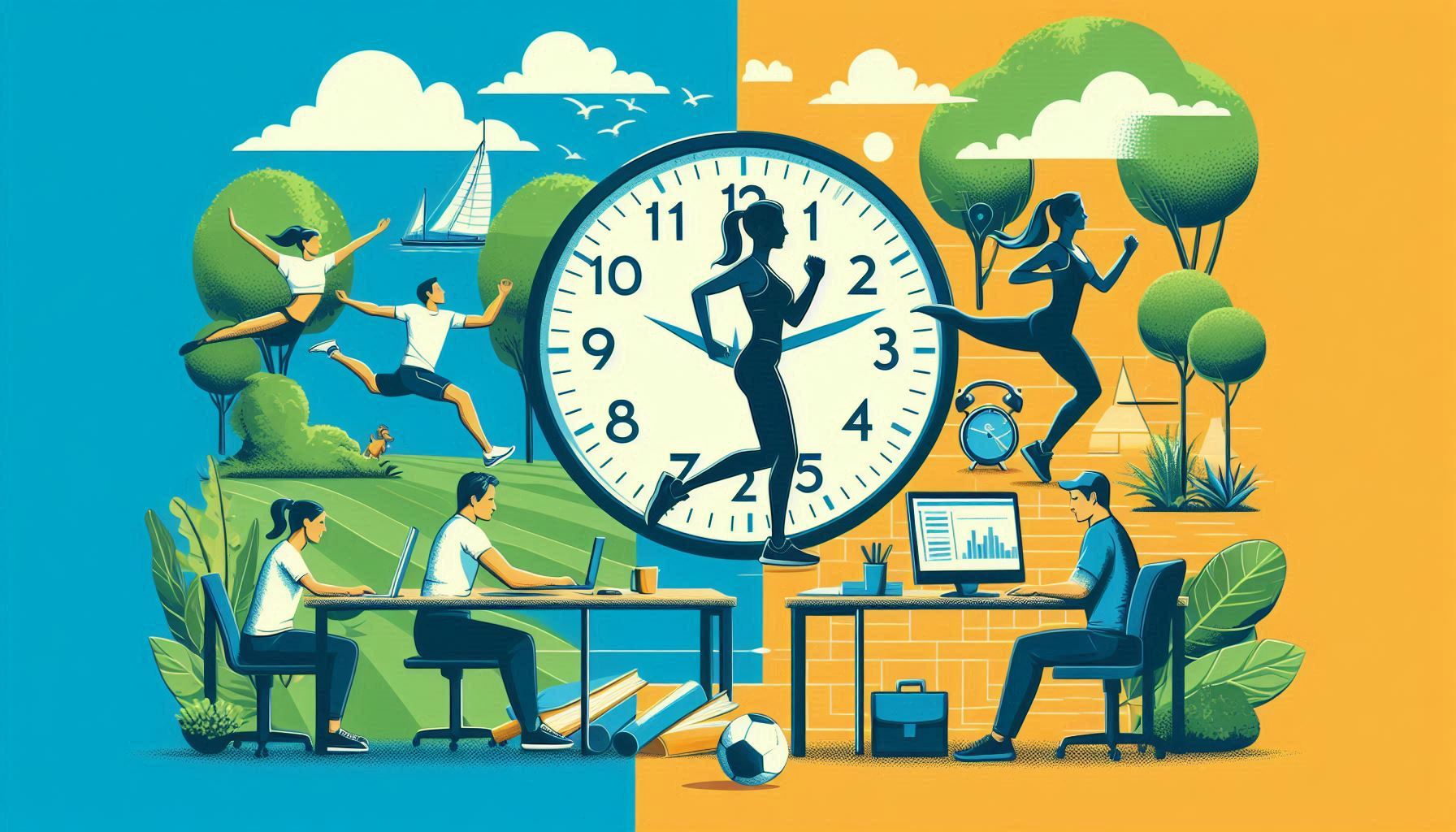How to Stay Fit: Solutions with Work-Life Balance
In today’s fast-paced world, maintaining physical fitness while managing a demanding career can seem like an insurmountable challenge. Juggling work responsibilities with personal health often feels like a delicate balancing act, especially when time constraints and stress levels can undermine even the best intentions. However, achieving a healthy work-life balance and staying fit are not mutually exclusive. With strategic planning, dedication, and lifestyle adjustments, it’s possible to harmonize professional demands with personal well-being.

Understanding the Importance of Fitness in a Busy Lifestyle
The relationship between physical fitness and work-life balance is crucial for personal and professional success. People often overlook the connection between their fitness levels and their performance at work, but exercise contributes more than just physical health. Regular physical activity boosts cognitive abilities, reduces stress, and fosters a more energetic, focused mindset. Ignoring fitness can have far-reaching consequences on both your physical and mental health, resulting in decreased productivity and overall well-being.
The Impact of Physical Fitness on Work Performance
Maintaining physical fitness is not just about aesthetics; it has significant implications for productivity and work performance. Regular exercise enhances cognitive function, reduces stress, and boosts overall energy levels. When you incorporate physical activity into your life, you experience a range of benefits that can directly impact your professional life. These include:
- Increased Productivity: Exercise improves focus and concentration, enabling you to complete tasks more efficiently. Physical activity helps increase blood flow to the brain, which sharpens alertness and enhances mental clarity.
- Reduced Stress: Physical activity triggers the release of endorphins, the body’s natural mood elevators. These chemicals help alleviate stress, improve mood, and provide a sense of relaxation, which is especially beneficial when handling high-pressure work environments.
- Better Sleep: Regular exercise contributes to better sleep quality, which is crucial for effective work performance. A well-rested mind is more capable of handling complex tasks, problem-solving, and creative thinking.
- Enhanced Creativity: Exercise stimulates brain function, potentially enhancing creativity and problem-solving skills. Engaging in regular physical activity encourages divergent thinking, allowing you to think outside the box and come up with innovative solutions at work.
The Consequences of Neglecting Fitness
Conversely, neglecting physical fitness can negatively impact your work life. Failing to stay active leads to more than just physical consequences — it can also have detrimental effects on your mental and emotional well-being. Some of the consequences of a sedentary lifestyle include:
- Increased Fatigue: Lack of exercise often results in decreased energy levels, making it harder to stay alert and productive throughout the day. Without regular physical activity, you may feel more sluggish and lethargic, reducing your ability to perform at your best.
- Heightened Stress: Physical inactivity can exacerbate stress and anxiety, affecting your overall well-being. A sedentary lifestyle makes it harder for your body to regulate stress hormones, leaving you feeling more overwhelmed and burnt out.
- Poor Health: A sedentary lifestyle is linked to various health issues, including cardiovascular disease, diabetes, obesity, and musculoskeletal disorders. Chronic illnesses and poor health can lead to more sick days and decreased work performance.
- Decreased Motivation: Poor physical health can lead to a lack of motivation and enthusiasm for work tasks. When you’re not feeling your best, it’s difficult to maintain the drive to achieve your goals.
Strategies for Staying Fit with a Busy Work Schedule
Achieving a balance between fitness and work may seem daunting, but it is possible with the right strategies. These practical tips can help you stay active, healthy, and fit without compromising your professional responsibilities.
1. Prioritize Your Fitness Goals
Setting clear fitness goals is essential for staying motivated and making time for exercise. Your goals should be specific, measurable, attainable, relevant, and time-bound (SMART). By following this framework, you’ll be more likely to stick to your fitness routine and track your progress. For example:
- Specific: “I want to run 5 kilometers.”
- Measurable: “I will track my progress using a fitness app.”
- Attainable: “I will start by running 1 kilometer and gradually increase my distance.”
- Relevant: “Improving my cardiovascular health is important to me.”
- Time-bound: “I aim to achieve this goal within three months.”
By breaking your fitness goals into manageable steps, you can make progress without feeling overwhelmed. Prioritizing fitness in your life starts with defining what you want to achieve and making the time to do it.
2. Integrate Physical Activity into Your Daily Routine
Incorporating exercise into your daily routine can help ensure that fitness becomes a natural part of your life, even when you’re busy. By blending fitness with your daily activities, you won’t need to carve out separate time for exercise. Consider these strategies:
- Active Commuting: Walk or cycle to work if possible. If you use public transportation, consider getting off one stop early and walking the rest of the way. Small actions like these can add up to significant physical activity over time.
- Standing Desks: Use a standing desk or an adjustable desk to reduce the amount of time spent sitting. Standing while working can improve posture and circulation, leading to better overall health.
- Short Workouts: Incorporate short, high-intensity interval training (HIIT) workouts that can be completed in 15-30 minutes. These workouts are effective and require less time commitment, making them ideal for busy schedules.
- Office Exercises: Perform simple exercises, such as seated leg lifts, desk push-ups, or stretching, during breaks. Even five minutes of movement every hour can make a significant difference in your energy levels and fitness.
3. Plan and Schedule Workouts
Treat exercise like any other important appointment by scheduling workouts in advance. When fitness becomes part of your daily or weekly schedule, you’re more likely to stick with it. Here’s how to plan effectively:
- Weekly Planning: Plan your workouts for the week ahead and add them to your calendar. Choose times that fit seamlessly into your daily routine, whether it’s early in the morning, during lunch, or in the evening.
- Flexible Scheduling: If your work schedule is unpredictable, have a backup plan for your workouts. For example, have a home workout option ready if you can’t make it to the gym, or take a walk during your break if time is limited.
- Utilize Breaks: Use your lunch break or other downtime for quick workouts or walks. Even a 10-minute brisk walk around the block can boost your energy and focus for the rest of the day.
4. Incorporate Exercise into Social Activities
Staying fit doesn’t have to be a solo effort. Combining socializing with physical activity makes fitness more enjoyable and less of a chore. This approach also allows you to spend quality time with friends and family while staying active. Consider these ideas:
- Active Social Events: Plan activities like hiking, dancing, or playing sports with friends and family. Socializing through physical activities makes exercise feel more like fun and less like work.
- Join Fitness Groups: Participate in group fitness classes, sports teams, or recreational leagues to stay motivated and socially engaged. Working out with others fosters a sense of accountability and keeps you motivated.
- Family Fitness: Include family members in your fitness routine by engaging in activities like biking, swimming, or playing outdoor games together. It’s a great way to bond while staying healthy.
5. Utilize Technology and Fitness Apps
Technology can be a valuable tool for maintaining fitness while managing a busy schedule. With various apps and devices available, it’s easier than ever to stay on track and motivated. Here’s how to leverage it:
- Fitness Apps: Use apps to track your workouts, set goals, and monitor progress. Apps like MyFitnessPal, Strava, or Fitbit can provide useful insights and motivation by logging your activity and achievements.
- Online Workouts: Access virtual workout classes or follow exercise videos online. Many platforms offer flexible workout options that can be done at home or in the office, making it easy to fit in a workout wherever you are.
- Wearable Technology: Invest in a fitness tracker or smartwatch to monitor your daily activity levels and set reminders for movement. Devices like Apple Watch or Fitbit track steps, calories burned, and exercise minutes, helping you stay accountable to your fitness goals.
6. Make the Most of Your Gym Time
If you prefer working out at the gym, make your time there as efficient as possible. The key to maintaining fitness when time is limited is maximizing every moment you spend exercising. Consider these tips:
- Plan Your Workouts: Have a clear plan for each gym session to maximize efficiency and avoid wasting time. Knowing which exercises you’re going to do ensures you get in and out of the gym faster.
- Use Time-Saving Equipment: Focus on compound exercises that work multiple muscle groups at once, such as squats, deadlifts, and bench presses. These exercises are highly effective and reduce the time spent working individual muscles.
- Avoid Peak Hours: Visit the gym during off-peak times to avoid crowds and wait times for equipment. Early mornings or late evenings are often quieter times at most gyms.
7. Stay Active During Work Hours
Long periods of sitting can negatively impact your fitness and health. To counteract the effects of a sedentary job, incorporate these habits into your workday:
- Frequent Breaks: Take regular breaks from sitting to stand, stretch, or walk around. Using techniques like the Pomodoro Technique, which involves working for 25 minutes followed by a 5-minute break, can help break up long periods of inactivity.
- Walk and Talk: Whenever possible, take walking meetings or phone calls. This not only adds extra steps to your day but can also improve your concentration and creativity.
- Standing Desks: Consider using a standing desk or alternating between sitting and standing throughout the day. Standing desks can reduce the risks associated with prolonged sitting and improve overall posture.
Conclusion
Staying fit while balancing work responsibilities requires a commitment to both your health and your career. By prioritizing your fitness goals, incorporating physical activity into your daily routine, and using strategic planning, you can maintain your physical and mental well-being without sacrificing your professional aspirations. Remember, the key to success lies in finding a balance that works for you. Taking small, consistent steps toward fitness, even in a busy schedule, will lead to long-term benefits for your health, happiness, and career.
SOURCES
Vantage Circle – 25 Best Ways To Achieve Work-Life Balance and Its Benefits
BetterUp – How to have a good work-life balance
Forbes – Experts Share How To Balance Work, Life, & Wellness
Healthline – SMART Fitness Goals Help You Stick with It
HISTORY
Current Version
September 17, 2024
Written By:
SUMMIYAH MEHMOOD
